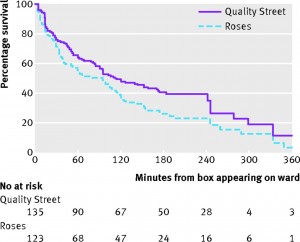Survival analysis of chocolate in hospital
You may remember StatsChat’s criticism of data quality and analysis in paper about chocolate and Nobel Prizes from a leading medical journal. Another leading medical journal, BMJ, traditionally has a Christmas issue with not entirely serious papers, typically based on good-quality silly research. One of the past highlights was the systematic review of randomised trials of parachute use.
This year, there’s a survival analysis of chocolate in hospital wards. Survival analysis is the branch of statistics working with the time until an event happens. Often the event is death, hence the name ‘survival’, but it could be something else bad, such as a heart attack, or something good, such as finding a job. If you’re a chocolate, it’s being eaten.
The data are a good fit to a constant hazard of consumption, with a rate of just under 1%/minute. There isn’t any sign of strong heterogeneity — if some chocolates are preferred to others, the preference is either not strong enough or variable enough between people that no chocolates are safe.
Other papers in the Christmas issue include a semi-serious comparison of stem cell size and structure for mice and whales, and the finding that, in Dublin, people called Brady are more likely to have pacemaker treatment for bradycardia (presumably a multiple comparison issue)
Thomas Lumley (@tslumley) is Professor of Biostatistics at the University of Auckland. His research interests include semiparametric models, survey sampling, statistical computing, foundations of statistics, and whatever methodological problems his medical collaborators come up with. He also blogs at Biased and Inefficient See all posts by Thomas Lumley »

Clearly we need to conduct exhaustive research on this topic, expanded into other locations (such as Christmas parties) and other confectionery (such as fruit jubes, potato crisps, and Dutch liquorice).
And then there’s a requirement to plan for environmentally-friendly disposal of any uneaten chocolate.
11 years ago
Love it! I foresee no trouble getting funding.
11 years ago
For mixed nuts, I’m pretty sure there is enough difference in palatability between species to ensure a decreasing-failure-rate distribution instead of the exponential distribution seen with chocolate.
For chocolates it would be interesting to see the impact of displaying or removing the guide to which one is which.
11 years ago
PS: this journal used to be called British Medical Journal. It officially changed its name to BMJ in 1988 (three years before KFC made the analogous change). As with KFC, the initialism BMJ had been in use for years. In contrast to KFC, style guides seem to have been slow to catch up with the change.
11 years ago
Something to worry about for the trial:
the “loss to follow-up” rate of the chocolates was high (26%). The main reason for this was that observers prematurely ended the continuous observation of the test boxes with chocolates. This was a clear violation of the protocol which writes (supplementary web information): “The observers will record data until both chocolate boxes have emptied”. This suggests that the trial was executed in a suboptimal way. Was there any monitoring of the trial by independent qualified persons, especially regarding the conduct (including any chocolate consumption) of the observers?
11 years ago